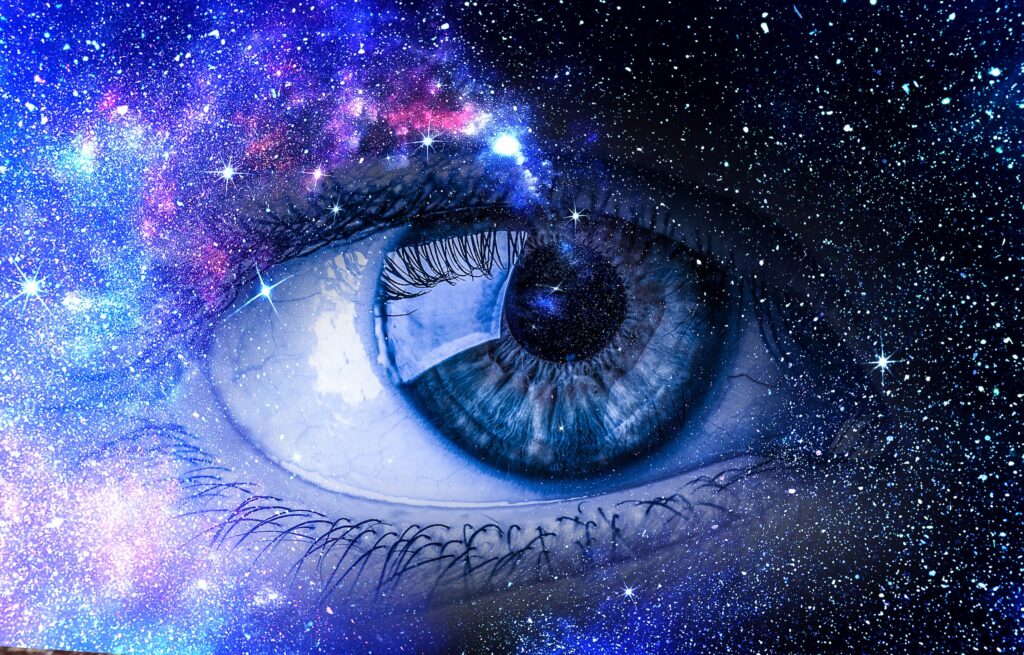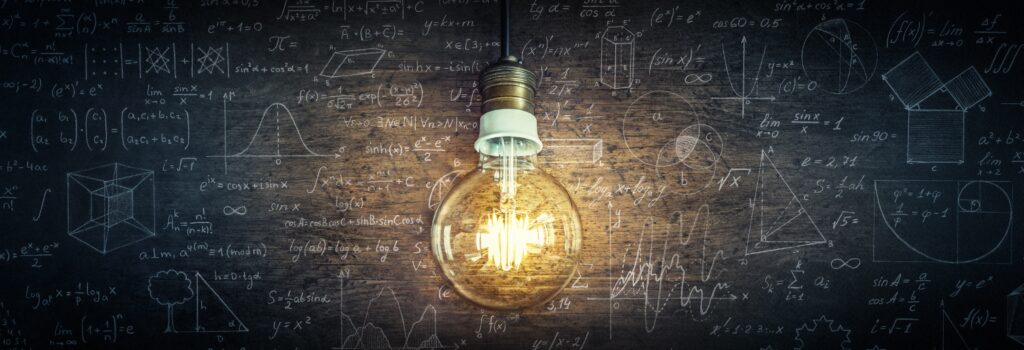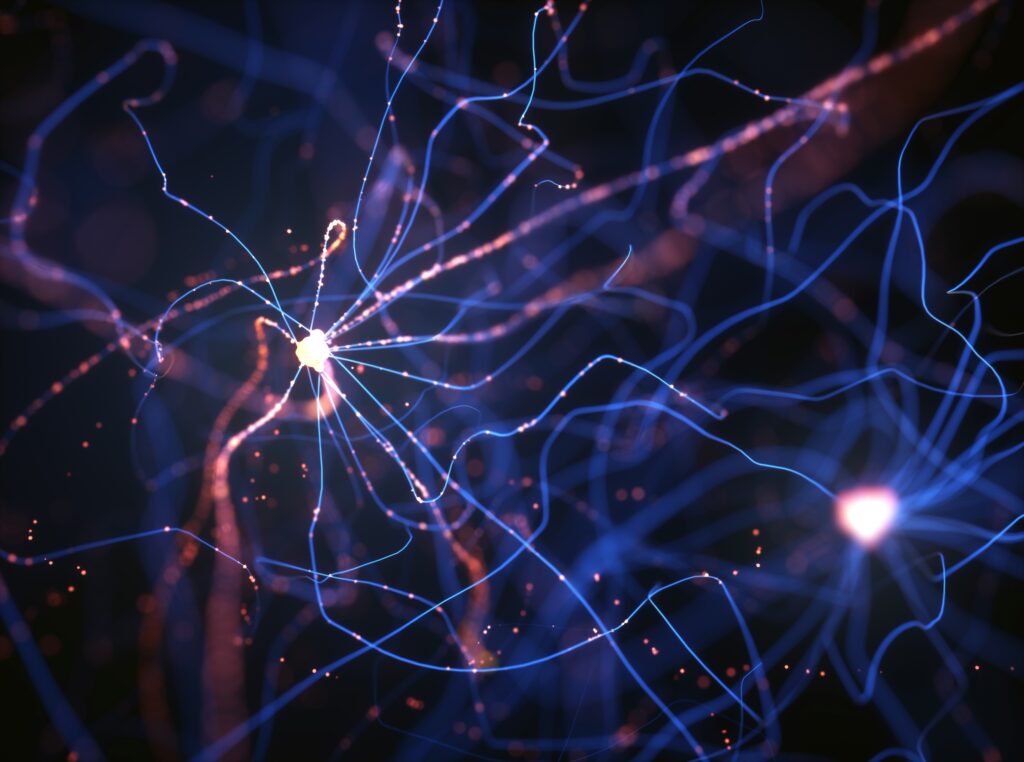Simulated selves in a simulated world
Reading | Philosophy
![]() Felix Haas | 2023-07-09
Felix Haas | 2023-07-09

The world we think we live in is but a projected tiling of our own concepts onto the scaffolding of external reality, and our personal selves mere illusions, argues Felix Haas. This is a thoroughgoing physicalist essay, which may raise the question: why is a foundation dedicated to idealism publishing it? We think it is an interesting piece for several reasons. In providing an informed ‘grand summary’ of the latest physicalist thought, this essay touches on important commonalities between modern physicalism and idealism. Amongst these are the notion that the personal self is an illusion, and that the world we perceive is as much a projection of our own conceptual categories as it is a standalone external reality. The essay also allows us to extrapolate the direction in which physicalism thought is evolving, as well as the ethos of that progression. Key to it is a kind of deconstructivist approach to self and world, in which our normal intuitions about what we are, and what the world is, are called into question. Importantly, this is the same ethos that underpins idealism. Our invitation to you, thus, is to question whether this essay goes far enough in addressing the very doubts it raises. Does it consistently and consequently pursue its own premises and conclusions to their ultimate implications? In our view, a truly self-consistent, critical investigation of how much we project our own concepts onto reality must call into question the notion of matter as a purely quantitative, empirically inaccessible ontological category. Might we be inadvertently projecting our own abstractions—our very concept of matter—onto reality as well?
That voice in my head that does the talking, that narrator of my thoughts and impressions, that is me. I exist. Every day I decide, I act, I experience and feel. This sensation of ‘me,’ my self, is real. Focusing only on what it is saying, rather than what our self is, we usually experience it as something like Descartes’ ghost in the machine. It is not surprising, then, that philosophers and religions over the millennia have invented daemons, souls, or the atman to inhabit our bodies and to be us. Even if you count yourself an atheist, who claims to disregard any kind of metaphysics, you might still believe your self to be some free-thinking, free-willed entity, distinct from your body, inhabiting it, rather than being part and product of it.
My aim here is to shed doubt on this notion.
But, before we get to the core of the argument, let me start by first trying to poke some holes into your everyday experience of your self. My hope being, that this might leave you more susceptible to what is to follow.
The self is not immutable and ever-present
It is difficult to give a satisfactory and exhaustive definition of what our self is. And still, we all have a seemingly intuitive understanding of it. Our sense of self is what we most identify with—that sense of being a small homunculus sitting behind our eyes, being the experiencer of our experiences, the thinker of our thoughts, the feeler of our feelings, the decider of our actions. Attempts at more analytical definitions of the self often include dissecting it into its different qualities. The neuroscientist Anil Seth, in his book “Being You” [1], for example, distinguishes the embodied, perspectival, volitional, narrative, and social self. Many scientists and philosophers, alongside Seth, have stressed that each of these facets are not constant and immutable, but can be altered. This is true even in everyday life.
We are all familiar with situations where the self becomes significantly less prominent. We speak of ‘losing our-self’ in work, of being in a flow state of high focus, fully identifying with a problem or activity, where our self becomes translucent. Likewise, our embodied self does not always inhabit the same boundaries. I am not referring to us growing or gaining weight, but the way we feel the boundaries of a car whilst driving or how we feel the limits of a racket when playing tennis. We learn to extend our sense of embodied self for tool use, helping us navigate complex situations.
Beyond everyday life, the perceived qualities of our self can be severely manipulated in experiment or through neuronal damage. Allow me pick some of Seth’s strata of the self and exemplify how readily hijacked they can be.
The Embodied self: Next to tool use, the ‘rubber-hand illusion’ is arguably the most canonical example. To create this illusion, a healthy subject’s left hand is hidden from his visual field and, instead, a rubber hand is placed in front of him. When an experimenter then starts brushing the rubber hand, interestingly, after a short while, the subject will start feeling the strokes he sees the rubber hand receiving.
The Perspectival self: Autoscopic hallucinations are situations in which the subject’s sense of the location of her self is not aligned with the location of her body. Out-of-body experiences (OBEs) are the most extreme examples in this category, where the subject experiences her self leaving her body and seeing it from the outside. Many cases of OBEs are documented, and neuroscientists have even been able to induce OBEs by electrically stimulating a patient’s brain [2]. Furthermore, OBE-like sensations have also been created virtually using cameras and virtual reality goggles.
The Narrative self: There are several documented cases of extreme amnesia. One of the most striking is the case of Clive Wearing whose hippocampi were left severely damaged after a brain infection. His condition has left him unable to experience his self as extended over time. Internal and external events that lie more than a few seconds in the past remain forever lost to him.
More astonishingly still, not only can the various facets of the self be significantly reduced, but total dissolution of any sense of self is also possible. One of the central objectives of Buddhism—particularly pronounced in Dzogchen—is trying to help its practitioners come to their own subjective experience of the absence of self, seeing their own consciousness devoid of self.
Outside of meditation, ritual dance, and hallucinogenic drugs, which can all induce a temporary absence of self, patients suffering from a psychiatric disorder called ‘Cotard’s syndrome’ seem to permanently lack any significant notion of self. As a result, they may stop using first person pronouns or even deny their own existence.
However, its reduction and dissolution are not the only arguments that call the fundamental nature and immutability of the self into question. It also seems possible to divide the self. This is the case in so called split-brain patients. These are people who had their corpus callosum, the neuronal bundle connecting the brain’s two hemispheres, severed either by accident or surgery (e.g. to treat forms of severe epilepsy). Both patients’ reports and experiments show that the two hemispheres of split-brain patients begin to function as independent minds.
What does it mean when we say the self is an illusion?
Few would doubt that our sense of self, and our experience of its qualities, is real. So, what do people mean when they claim that our self is an illusion? As Sam Harris puts it in his book “Waking Up” [3], “like many illusions, the sense of self disappears when closely examined.” It is the idea of our self as the originator and audience of our thoughts, actions, feelings, which Harris and others have called into question. Meditation often starts with the realization that thoughts enter and leave consciousness without there being anything like a thinker. In this way, you can see your self to be but one concept—albeit a seemingly pervasive and pivotal one—amongst many populating your consciousness at any point in time.
Some people, Anil Seth amongst them, have taken issue with labelling the self or its qualities ‘illusions,’ rightfully pointing out that it is just as real as ‘redness’ or ‘blueness’ [1]. Yet, both Harris and Seth would likely agree that the self is constructed (that is why it can be deconstructed) by our brains, and that it does not exist independently of them. Importantly, in being assembled by our brain, our self is not set apart, but in line with nearly everything else we experience.
The world we experience, our phenomenological world, is not the way the world really is. There is a map between the two, which must preserve certain primary aspects of reality, such as the volume and elasticity of objects, their relative positions, or velocities. However, qualities like ‘redness,’ ‘chairness,’ ‘sweetness,’ and many other dimensions in which we experience our world, live only in our internal models of the world, not in the world itself. We experience the world in a manner that is useful to us, not in the way it really is.
Things in the world have no smell or taste, yet the molecules they emit give us clues about how edible, dangerous, or ready for mating they might be. Humans, for instance, have five senses—six when adding balance. Other animals have different sets of senses, some of which are completely alien to us, such as echolocation (e.g. bats) or electroception (e.g. sharks). And even when considering the same category of sense across species, different instantiations of this sense are bound to create different internal worlds. It is how a perceived object scores against an individual’s four F’s—fighting, fleeing, feeding, and sex—that determines how attractive or repulsive it is constructed by that individual’s brain.
Historically, we think of perception as happening outside-in: The world impacts our senses, which send signals to different brain networks that ultimately decide what it is we are seeing. However, this view is being challenged (see e.g. [4]) and gradually replaced by an opposing, inside-out view: Our brain predicts what it is we might see in the next moment, which then gets validated against incoming sensory data. We can only see a car or a laptop if our brain already knows the concepts ‘car’ and ‘laptop.’ We would always be able to see the object that is a car. But, if we had never seen, heard of, or experienced any other mode of transport but our own two legs, we would only be able to recognize a car’s shape, size, color, etc.—we would not see any of the essence of what makes a car a car. In short, we would not see a car, but only a hallow block of painted metal.
Cognitive neuroscientist Lisa Feldman Barrett extends the idea of knowing a concept as a prerequisite to perceiving it far beyond the outside world. She understands interoception, perceiving our bodily states and signals, working in precisely the same way. Our brain reads bodily data like our breathing or heartbeat and uses socially shared emotional concepts (anxiety, love, hate, Schadenfreude, etc.) to predict what emotional concept best fits our state in each context. Deciding for a matching emotional concept, according to Feldman Barrett, is feeling that emotion. The concept comes before the emotion—we can only feel betrayal, if we already know the concept ‘betrayal.’
Concept building and concept matching, to Feldman Barrett, is also what gives rise to our experience of the self. “In my view,” she writes in her book “How Emotions Are Made” [5], “the self is a plain, ordinary concept, just like ‘Tree’. It is a goal-based concept in which the goal shifts based on context.”
Both Seth and Feldman Barrett paint our minds as predicting machines that read out signals from extero- and interoception, as well as from our brain itself, and match them against evolving concepts to decide what is in the world and what is ‘in our hearts,’ i.e. our feelings and desires. However, this decision lies not with our self—rather, this process runs almost entirely subconsciously. Our self is a product of this prediction-construction process, not its origin.
We are brains in bony cages who receive electric signals from our sensory organs. We then build models of the origins of these signals and call it the world. And we treat ourselves no different, because building our world model with us in it is the best that we can do. Our body, our feelings, our sense of self are model-elements that represent best guesses at what there is—with the word ‘best’ not being meant ontologically, but pragmatically. That is, our world-model is not constructed to be closest to the way the world really is, but such that we maximize our ability to navigate it and to achieve our goals of survival and reproduction.
Cognitive psychologist Donald Hoffman has long argued (see e.g. [6]) that a core idea of classical evolutionary epistemology is mistaken—namely, that evolutionary fitness would naturally drive our internal models progressively closer to the world as it really is. Hoffman, who has devised numerous experiments and simulations to support his claim, chooses the desktop metaphor to illustrate his point. We know that the computer desktop is not literally how our computer is organized or functions. Humans have designed and built all its hardware and software, none of which contains a literal desktop. The desktop is merely an abstract representation layer that enables the human user to navigate it more easily. Hoffman sees our internal model’s relationship to the outside world in much similarity to the desktop and the computer: a relationship that does not optimize for faithful representation, but for ease of navigation.
Why don’t we experience the world as a model?
If the world we experience is merely a model that our brains create, why don’t we perceive it as such, as a model? Why, instead, is our world-model what philosophers call ‘transparent’? That is, why does everything seem so real, with no scaffolding showing? Why don’t we, for example, perceive the process of how our brains decide whether something has ‘redness’ or not?
Thomas Metzinger—in his book “Ego Tunnel” [7]—answers this question by pointing towards evolutionary fitness. What would be the consequences, he asks, if our model of the world was opaque, and we could see the workings of the model itself? First, to not be significantly disadvantaged compared to a brain producing a transparent world-model, a brain producing an opaque model would still need to construct the same world content, but face additional metabolic expenditure to create whatever additional impressions represent the workings of the model itself. This is contrary to the basic strategy of how our brains evolved, trying to automate as many processes as possible, running them subconsciously at lower energy requirements.
But, even if energy were not an issue, our attention and ability to act would likely be impaired by an opaque world-model. If we no longer perceive only the content of our model, but also its workings, we might often focus on the latter, without gaining any evolutionary advantage. Our attention might be captured by observing how our model creates our phenomenological world, rather than focusing on model content, which alone influences our survival and procreation abilities.
What about free will?
The fact that an individual’s actions can be meaningfully influenced is what social media and online marketing build their business models around. More strikingly still, people—after having been subconsciously coerced into a specific action—will often concoct explanations for why they believe they chose what they did not [8]. What is not in itself a watertight argument against free will, does at least prove that we are able to convince ourselves that we are completely free to choose even in situations where we are not. It shows the propensity of our mind to invent volition.
Our biochemistry, genes, culture, and social surroundings, even our microbiome, are part of a long list of factors that influence our actions. However, some might want to brush this off as shaping our ‘character’ and ‘mood,’ rather than limiting or even negating our free will.
There are neuroscientific arguments, most famously the Libet experiment, in which the build-up of a so-called readiness potential in a subject’s brain is used to read out the subject’s imminent choice before they themselves become aware of it. However, variations of this classical experiment by other scientists [9] have raised some doubts about the original interpretation. Other defenses of free will call Libet’s classical interpretation into question by distinguishing between choosing an action and becoming aware of the choice. For some, philosopher Daniel Dennett [10] amongst them, such an implicit redefinition of ‘free will,’ which includes our subconscious, circumvents the Libet experiment being the last nail in the free will coffin. Others, counting Sam Harris [11], question whether this flavor of compatibilism is still talking about the thing that the free will debate set out to discuss.
The argument against free will, however, which holds the most punch, is that of determinism. As far as we know today, the future is determined by the past plus intrinsically random quantum fluctuations. In such a world, in our world, how do you insist on free will without violating the laws of nature?
Compatibilists of free will and determinism have more than struggled to find a convincing loophole to get to have their cake and eat it too. Typically, their arguments involve redefining the terms ‘free will’ or ‘self,’ along the lines of what we just discussed, or trying to find agency in quantum randomness. The former arguably fails to address the original problem. The latter lies outside of any accepted science or interpretation thereof.
Even without evoking our prior discussions on the predictive nature of our minds and the nature of the self, the volitional self and the concept of free will are near impossible to vindicate. Adding our prior conclusions to the discussion, does not make the compatibilist’s challenge any easier (what is free will without a self?). “We project causal power into our experience of volition in just the same way that we project redness into our perceptions of surfaces,” Seth writes in “Being You.”
Why does it all matter?
We typically meet attacks on ideas that give meaning or identity to our existence with hostility. The idea of our self as our brain’s simulation, lacking coherence and free will, not only goes against most of our everyday experiences but, put very simply, hearing it doesn’t feel very good. However, neither our emotional resistance, nor our intuition are fair arguments for keeping with these notions. My liking something or not has no bearing on its truth. And there is an abundant list of what we now accept as fundamental aspects of reality where our intuitions have led us astray for millennia—from the idea of a spherical earth and the heliocentric worldview to the ontological insights of quantum mechanics and general relativity.
But why does it all matter? Unlike quantum mechanics and general relativity, the realization of the true nature of the self is unlikely to allow us to build next-generation machines. Rather, you may worry that the absence of free will negates moral responsibility. Much has been written (see e.g. [11] for a short introduction, or [12] for an extensive treatment) on why this is not the case, which I do not intend to reproduce here. However, if our will indeed is not free, then it has always been this way, and so, it might suffice to ask, why our ethics and justice system should disintegrate with the realization of this truth?
On the other hand, realizing the illusionary nature of free will does further enable us to build criminal justice systems around the principles of deterrence, security detention, and rehabilitation, rather than revenge.
Little collective or individual happiness has come from the agrandizement of one’s nation, race, or self. Instead, psychology and self-help literature is ripe with arguments for deflating our ego and self-focus and for finding meaning in something larger than ourselves. After realizing that you are no longer—and never were—the all-controlling CEO of your body and actions, you may choose to be liberated rather than impoverished. Rather than seeing the self-simulation as a bleak truth, you can choose to take it as a call for further introspection and first-person exploration of the structure and possibilities of your own consciousness. You may realize that the fact that all your perceptions, including your own feelings, are constructed by your brain, means that it is not the world that angers you or makes you happy, but your own mind. You may also come to find a greater deal of intellectual humility and empathy. You may be less certain of the finality of the conclusions you draw and thus more receptive to criticism. Likewise, you may be more careful and forgiving when believing that you have spotted errors in others’ conclusions or actions.
Finally, you may find beauty in the idea of how, in an expanding, slowly cooling universe, complexity built over time to give rise not only to life, but eventually also to conscious minds. Through us and other minds before and after us, the universe started modelling and understanding itself. We are not divine souls, beings from a different realm that inhabit our physical bodies, but literally all we are is the stuff that the universe is made from.
References
[1] Seth, Anil (2021). Being You: A New Science of Consciousness. Faber & Faber.
[2] Blanke, O. et al (2002). Stimulating illusory own-body perceptions. Nature 419, 269-270.
[3] Harris, Sam (2014). Waking Up: A Guide to Spirituality Without Religion. Simon & Schuster.
[4] de Lange, F. P., Heilbron, M., and Kok, P. (2018). How do expectations shape perception? Trends Cogn. Sci. 22, 764–779.
[5] Feldman Barrett, Lisa (2017). How Emotions are Made: The Secret Life of the Brain. Houghton Mifflin Harcourt.
[6] Hoffman, Donald D. (2019). The Case Against Reality: Why Evolution Hid the Truth From Our Eyes. W.W.Norton & Company.
[7] Metzinger, Thomas (2009). The Ego Tunnel – The Science of the Mind and the Myth of the Self. Basic Books.
[8] Robson, David (2015). The hidden tricks of powerful persuasion [online]. BBC Future. Available from: www.bbc.com/future/article/20150324-the-hidden-tricks-of-persuasion
[9] Schurger A, Sitt J, Dehaene S (2012). An accumulator model for spontaneous neural activity prior to self-initiated movement. Proc Natl Acad Sci USA 109: E2904–E2913.
[10] Dennett, Daniel (2003). Freedom evolves. Penguin.
[11] Harris, Sam (2012). Free Will. Free Press.
[12] Parfit, Derek (2011). On What Matters, vols. 1 and 2. Oxford University Press. and Parfit, Derek (2017). On What Matters, vol. 3. Oxford University Press.

Essentia Foundation communicates, in an accessible but rigorous manner, the latest results in science and philosophy that point to the mental nature of reality. We are committed to strict, academic-level curation of the material we publish.
Recently published
Reading
Essays
Seeing
Videos
Let us build the future of our culture together
Essentia Foundation is a registered non-profit committed to making its content as accessible as possible. Therefore, we depend on contributions from people like you to continue to do our work. There are many ways to contribute.















